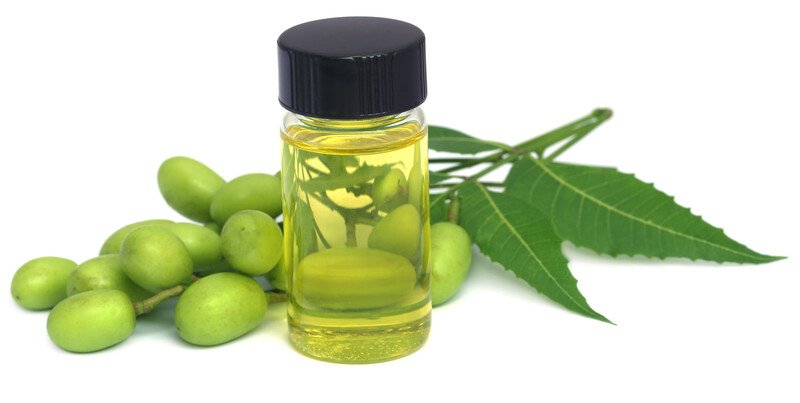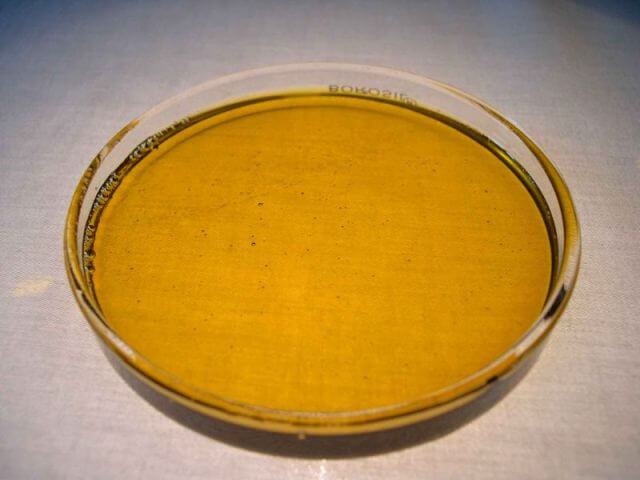This post contains affiliate links. If you click on a link and make a purchase I earn a commission at no extra cost for you.
Neem oil is a natural, environmentally friendly pesticide that is obtained from the seeds of the Neem Tree. The purely organic oil is effective in the fight against a wide variety of biting and sap-sucking pests such as aphids, beetles, caterpillars or mites, and fungal diseases that can cause considerable damage to crops.
What is Neem Oil?
Neem oil is a vegetable oil that is extracted from the seeds of the Neem Tree (Azadirachta indica). The evergreen tree is also known as India Lilac, it is endemic to the Indian sub-continent and has been used there for many centuries. Today it is commercially grown in many other parts of the tropics. Its bark, leaves, and seeds are used.
The Neem oil which is extracted from the seeds is of great commercial importance. It is used in many products from cosmetics, in Ayurveda, and in organic agriculture and horticulture for its insecticidal and fungicidal properties.

Extraction and active ingredient
The Neem oil extracted from the seed of the tree act as a natural insecticide and fungicide. It is yellow to brown in color. It has a bitter taste and a garlic-like smell. The most active component that acts on various pests is Azadirachtin. It can be obtained from neem oil.
Extraction is from the fruits, seeds, or seed kernels by different methods. Some of the methods include cold-pressing, solvent extraction, or high-pressure extraction.
The highest quality of neem oil is produced by cold pressing, this is also the oldest method to extract the oil. This cold-pressed high-quality oil is primarily for external use for skin care and in Ayurveda.
- The very first step is to remove the pulp from the seeds. Then the seeds are air-dried in a cool room with low humidity. Afterward, the husks of the seeds are removed before extraction.
- The fresh and light green kernels are crushed and pressed to release the oil, which is then collected.
- Cold-pressing method yields high-quality virgin oil which contains all the active ingredients.
Secondary pressing or using solvent extraction methods produce an inferior oil, which is obviously cheaper but still of good quality that is good for manufacturing soaps and insect repellents or for use in organic agriculture.
High-pressure steam extraction produces the lowest quality. The resultant oil is dark in color and emits an unpleasant odor. The disadvantage of this method is that the oil’s valuable properties are potentially destroyed by the application of heat.

How does neem oil work as an insecticide?
In nature, plants serve as the basis of the food chain. Since plants cannot run away, they have developed other mechanisms to protect themselves from predators. They produce organic compounds that have a deterrent or toxic effect on predators.
Neem oil consists of several different organic fatty acids and terpenes including Azadirachtin and linoleic acid. Azadirachtin is the most active ingredient in the oil and affects the metabolism of the bug by disrupting the synthesis of chitin. This prevents the larvae from successfully skinning and pupating, the insect cannot proceed to the next step in the growth cycle.
It also interferes with the insects’ eating behavior and has a repelling effect.
Does Neem Oil Kill Ticks?
As the main active ingredient in the oil, azadirachtin, acts as an inhibitor in chitin synthesis it also acts on ticks. Regular chitin synthesis is vital for ticks to grow and morph to the next stage in their life cycle. So while neem oil does not directly kill ticks, it does prevent growth. In the case of ticks, this means that the development, from egg to larva, to nymph, to adult is interrupted. Neem oil does not directly kill ticks, but as it affects their growth and development, regular application of neem will help reduce tick populations in the yard.
Side effects and dangers
Creams, shampoo, and other skin care applications are safe when applied externally to the skin and body.
But Neem oil MUST NOT be taken by mouth. Fortunately, it tastes horrible. It can cause miscarriage when taken by the mouth during pregnancy. It can also cause vomiting, diarrhea, seizures, brain disorders, and coma in children when taken by mouth. In pets such as cats, the oil can cause excessive salivation, impaired movement, twitching, and convulsions.
Benefits of neem oil
Neem oil is rich in fatty acids (e.g. palmitic and oleic acid), so it keeps the skin healthy and fresh. It also has anti-aging properties. It promotes wound healing. It is effective as an insecticide and is used to repel and control insect pests.
It is non-toxic to birds, bees, earthworms, plants, and mammals. Azadirachtin can be slightly toxic to fish, aquatic organisms, children, and pregnant women. It is biodegradable and not harmful to the environment.
Uses of neem oil
- In cosmetics, it is in many forms including gels, lotions, soaps, creams, and shampoo. Diluted in creams and lotions it is applied to the skin as a cleanser. Used to eliminate head lice and to get rid of dandruff. Applied to the areas of skin that are affected by scabies infestations. It will reduce itching and inflammation. Soothes skin diseases such as cold sores and fungal skin conditions.
- Household, as lamp oil or as a lubricant.
- Agriculture, seeds, and oil are used as fertilizers and for the control and prevention of insect, nematode, mite, and fungal infestations.
- Insecticide and repellent help to control many parasites including mites, ticks, fleas, and lice.
Neem oil as a repellent in humans
In humans, topically applied, it can be used as a mosquito and tick repellent. Because of its insecticidal effects, it is often used as an ingredient in organic insect repellents. It is also used to eliminate head lice and to treat scabies in humans.
In its pure form is very potent, uses sparingly, a few drops only.
The best is to dilute it with a carrier such as a coconut-, almond-, olive- or jojoba oil in a ratio of about 1 to 10, that’s about half a teaspoon Neem to an ounce of carrier oil.
How to use it?
To eliminate lice, neem extract shampoo is applied to dry hair for 10 minutes. Then rinse with warm water. The process can be repeated for good results.
As insect or tick repellent use is diluted in a carrier oil, or buy a finished product that contains neem and topically spray or rub to skin and clothing.
Last update on 2024-04-27 / Affiliate links / Images from Amazon Product Advertising API
Neem oil as a repellent in pets
In dogs, it can be used as an effective pesticide against external parasites. It works against mites, ticks, and fleas. It has antibacterial, antiviral, and antimicrobial properties and is effective against infections and microbes that cause itching in pets.
How to use it?
Neem oil is diluted with another carrier such as coconut-, almond- or olive oil and then it is applied directly to the animal’s skin and hair. It can also be applied in the form of shampoo or spray. Massage the oil with your fingers. It will stop itching. Apply the oil twice a day at first, then once a day when the healing has begun.
As Pesticide In Yard and Garden
The main use of neem oil is in the garden to protect plants from insect pests. Used properly, it acts as a potent organic pesticide to control pests in the yard and around the house. But it not only acts on insects that are harmful to plants, but it also reduces tick populations.
It is an excellent natural way to control insect pests, but at the same time it is harmless to the many beneficial insects we need in the garden, and it is also harmless to pets and livestock.
Rid fruit trees from plants pest
Spraying infested plants with water to which neem oil has been added causes the small sap-sucking beasts to die off. The active ingredient in the oil disrupts the metabolic cycle and the synthesis of chitin. The growth of the insect larvae and pupae is inhibited. The pests die off completely after a few days and the plant is pest-free again.
How to use it?
Neem oil has to be diluted, at the rate of two tablespoons per gallon of water. After mixing it thoroughly, spray over all plant surfaces until they are wet completely. As a preventive measure spray it on a 7 to 14-day schedule. To control the pests or diseases that are already present, a 7-day schedule is recommended.
Last update on 2024-04-27 / Affiliate links / Images from Amazon Product Advertising API
Conclusion:
Neem oil is a truly versatile natural remedy for reducing insect pests in the garden. It has a lot of benefits. It is available in the form of gels, soaps, shampoo, creams, and lotions. It has antimicrobial and antibacterial properties. Besides this, it acts as an effective insecticide to kill and control insect pests. It also helps to repel ticks, mosquitoes, and other parasites.
Sources and more to read:
Fact Sheet:
http://npic.orst.edu/factsheets…..en.html
US National Library:
https://www.ncbi.nlm.nih.gov/pmc/articles/PMC4791507/





